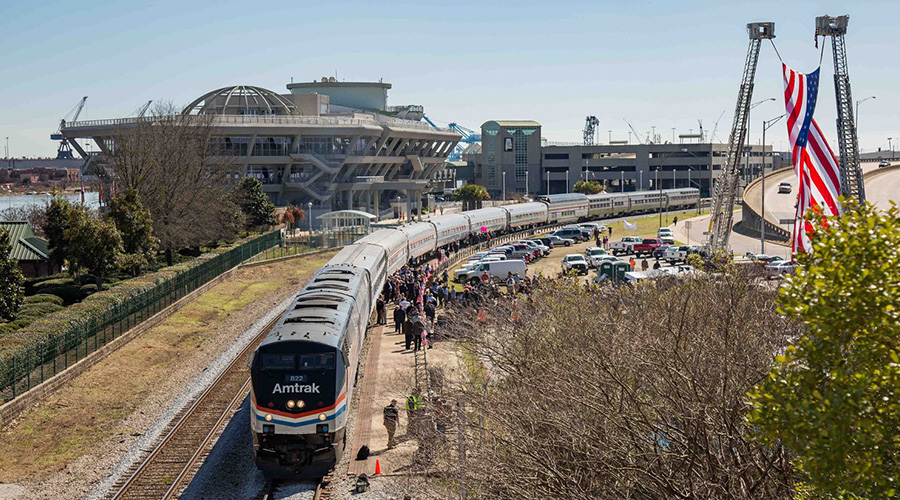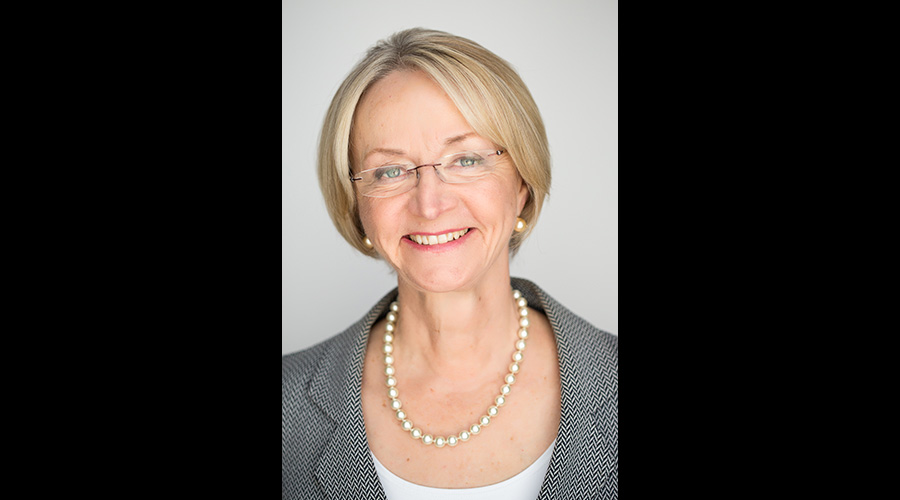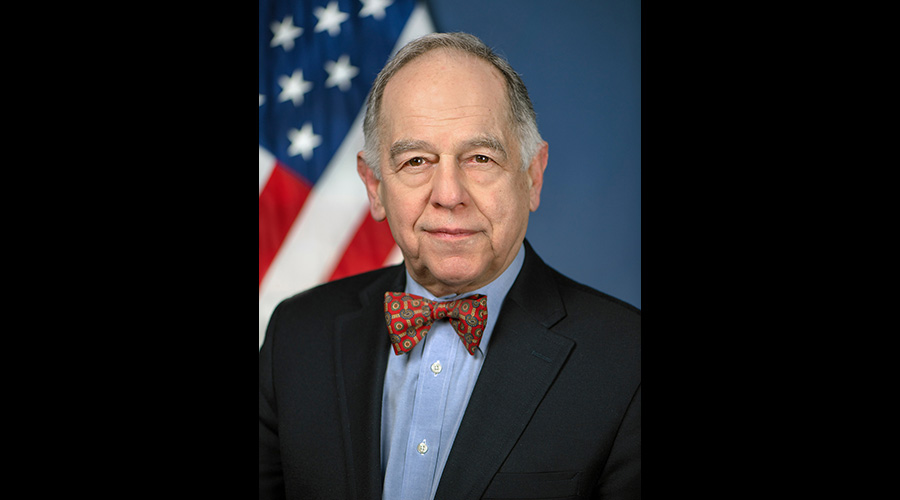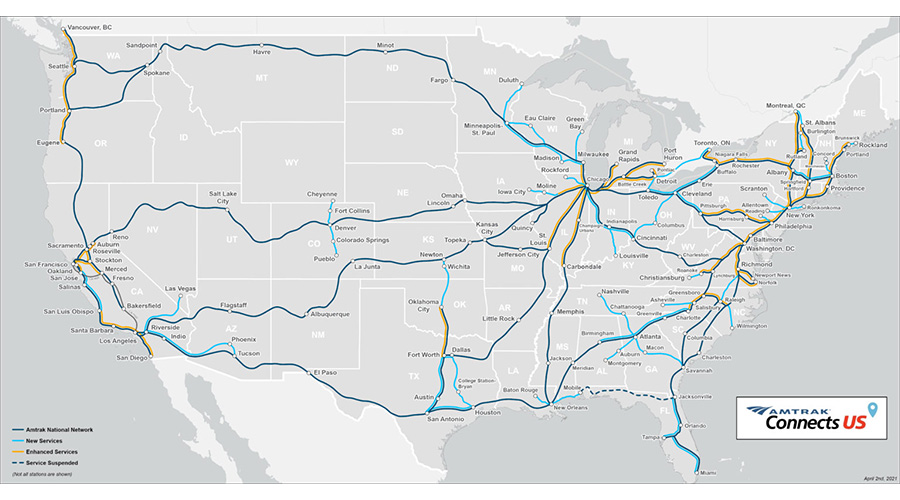STB to Amtrak: When will Gulf Coast service roll out?
2/16/2024
By Julie Sneider, Senior Editor
A Surface Transportation Board hearing held Feb. 14 on Amtrak’s proposal to resume train service on a Gulf Coast rail line can be viewed as an example of the challenges the railroad faces in achieving its ambitious goal to bring passenger rail to every major U.S. metro area by 2035.
The STB called the hearing to receive an update on an agreement reached in November 2022 between Amtrak, CSX, Norfolk Southern Railway and the Alabama State Port Authority. Board members wanted to know when Amtrak’s two proposed daily round trips between Mobile, Alabama, and New Orleans would begin operating.
The case before the STB dates to March 2021, when Amtrak petitioned the board to force CSX and NS to allow the passenger railroad to run trains on the Class Is’ track along the Gulf Coast between New Orleans and Mobile. Amtrak service has been unavailable in the area since Hurricane Katrina swept through in 2005.
In its petition, Amtrak said it has the legal right to run trains on the route. But Amtrak and the two Class Is disputed who was responsible for various infrastructure costs and whether Amtrak’s use of the line would interfere with freight-rail traffic serving the Port of Mobile and other regional economic interests. The STB held numerous hearings on the matter over the next year, and strongly encouraged the parties to find a solution on their own.
By November 2022, Amtrak, CSX, NS, the port authority and its Terminal Railway Alabama State Docks announced a settlement, the details of which remain confidential. In September 2023, the Federal Railroad Administration announced it would award a $178.4 million grant through the Consolidated Rail Infrastructure and Safety Improvements (CRISI) program to help fund the capital costs involved in restoring Amtrak service on the Gulf Coast route.
 “Amtrak is making no little plans. But it has to figure out how to implement them.” — STB Member Karen Hedlund stb.gov
“Amtrak is making no little plans. But it has to figure out how to implement them.” — STB Member Karen Hedlund stb.govIn November 2023, the STB continued to hold the Amtrak petition “in abeyance” so the three railroads could work out the details, such as plans for constructing a 3,000-foot layover track, Mobile station facilities and additional track, the design and construction of which must meet FRA and federal environmental requirements.
Early this year, STB Chairman Martin Oberman ordered a status report, due Feb. 1, and set the Feb. 14 hearing to hear in person when the Amtrak Gulf Coast trains would start running.
In the Feb. 1 report, the parties said they were working through the terms and conditions in the agreement. The report stated Amtrak is working with the FRA to iron out the details of the final CRISI grant agreement; Amtrak and CSX executed a design and construction agreement for the layover track project and they’ve worked “diligently and cooperatively on all design and pre-construction activities over the past few months." Amtrak is preparing the environmental reports that the FRA must review.
The track project also depends on Amtrak successfully negotiating a land-use agreement with the city of Mobile to govern the railroad’s construction and use of the platform on city-owned property; Amtrak and the city are negotiating that agreement. The parties also said the Feb. 1 report contains all the information currently available, so there was no need to hold the Feb. 14 hearing.
 “I think the public has a right to transparency in a transaction that involves millions and millions of [taxpayer] dollars.” — STB Chairman Martin Oberman stb.gov
“I think the public has a right to transparency in a transaction that involves millions and millions of [taxpayer] dollars.” — STB Chairman Martin Oberman stb.govOberman called the Feb. 14 hearing anyway. After attorneys representing Amtrak, CSX and NS explained the project’s status to date, Oberman and board members didn’t hide their frustration and disappointment at what they considered to be slow progress toward the end result: launching passenger service.
For example, Oberman and board members asked:
• Why didn’t Amtrak begin planning design and construction discussions earlier, even before the CRISI grant announcement?
• Why was it taking Amtrak so long to negotiate a lease with the city of Mobile for property needed for track and related infrastructure?
• Why wasn’t a service operating agreement yet settled? And why didn’t the Feb. 1 status report include information on an apparent sticking point with the city over an operating subsidy?
Oberman also complained that certain project details weren’t mentioned in the status report and that he only learned about them from Alabama media reports. He encouraged the group to be more open about their actions and progress.
“I think the public has a right to transparency in a transaction that involves millions and millions of [taxpayer-supported] dollars,” Oberman said. “... There is an overuse of confidentiality, generally, in my view. This is not just a private business transaction.”
Attorneys for all three said the railroads have made a lot of progress since Amtrak first filed its petition. The parties, along with the FRA, are working as quickly as possible to wrap up all outstanding matters so service can begin before the end of 2024, they said. Specifically, they’ve agreed that service can begin as soon as the Mobile station track project is wrapped up; the CRISI grant agreement is executed; and negotiations with the city are completed. If the CRISI agreement isn’t executed by May 1, the parties will submit another progress report, Amtrak attorney Jessica Amunson said.
But Oberman wasn’t having it. He told the group that he wants a status report — including a more precise estimate of when train service will begin — in 30 days.
In her comments, STB member Karen Hedlund said she’s concerned about what this Gulf Coast case says about Amtrak’s ability to meet its goals in expanding passenger rail throughout the United States.
She quoted remarks recently made by Amtrak CEO Stephen Gardner in Baltimore, where he said that “Amtrak has rebounded from the pandemic,” is growing again and plans to double ridership by 2040. Hedlund also cited the “Amtrak Connects US” plan, which calls for improving service on 25 existing routes and the addition of 39 new routes so that passenger rail can be available in every major U.S. city. Presently, only the top 27 — out of 50 — metro areas have direct passenger-rail service.
“I am a big champion of Amtrak’s vision, and have been for years,” Hedlund said. “One reason I wanted to be on this board is to further that vision. But doing all this [passenger-rail expansion] will require a lot of effort in partnership with the Class Is.”
 The map illustrates the ambitious “Amtrack Connects US” plan to expand passenger-rail service across the United States. amtrak.com
The map illustrates the ambitious “Amtrack Connects US” plan to expand passenger-rail service across the United States. amtrak.comThose looking to Amtrak to bring new passenger service as outlined in its ambitious plans may find that the Gulf Coast case has taken two years — and still no trains are running — “a little disheartening,” Hedlund added.
A native Chicagoan, Hedlund cited a quote from architect Daniel Burnham, whose architectural designs famously changed the city’s landscape. “Make no little plans; they have no magic to stir men’s blood,” Burnham once said.
“Amtrak is making no little plans. But it has to figure out how to implement them,” said Hedlund.
Board member Robert Primus concurred, telling the railroads that he’s supportive of passenger rail but is concerned about what the Gulf Coast example says about the future of Amtrak expansion to other cities.
“If we go down to the end of this year and the trains still aren’t running, I would hate to have all of you back here to ask, ‘why not?’” Primus said. “We are past due for getting this done. It’s time to stop shaking hands and start moving trains."


